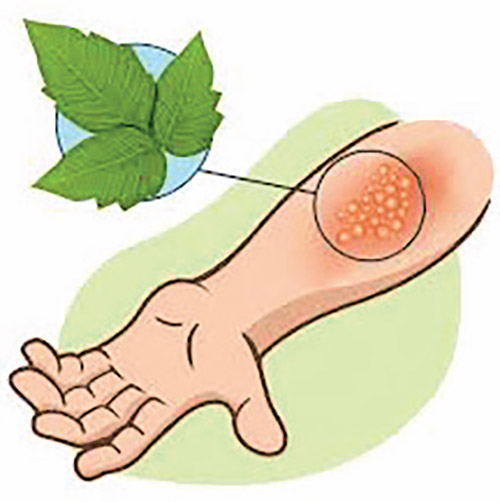
If you like hiking or gardening, here are some tips to help you enjoy your time outdoors without bringing home a poison ivy rash.
Prevention Tips
- 1. Before you go outside, look up photos of poison ivy, poison oak and poison sumac online so you can recognize and avoid them if you encounter them.
- 2. Besides avoiding these plants, you should also avoid touching anything that has urushiol (the oil that causes the rash) on it such as gardening tools, sporting equipment and even a pet’s fur or leash.
- 3. When you go hiking, wear long pants, long sleeves and boots to cover and protect your skin.
- 4. Apply an over-the-counter ivy block barrier before going outside on a hike. This helps prevent the skin from absorbing the urushiol.
Treatment Tips
Most people can safely treat the rash at home or can seek treatment from a dermatologist.
- 1. After touching poison ivy, poison oak or poison sumac, immediately rinse your skin with lukewarm, soapy water.
- 2. Wash the clothes and shoes that you were wearing when you came into contact with the poisonous plant. Use warm, soapy water to wash everything else that may have the oil on it. Keep in mind that the rash is not contagious. It is a person’s allergic response as a result of coming into contact with the urushiol oil from the plant.
- 3. Take a short, cool shower or a short, lukewarm bath in a colloidal oatmeal preparation to ease the itch.
- 4. Do not scratch the itchy skin or pick at the blisters. For a mild case, apply hydrocortisone cream to soothe the itchy skin or apply a clean, cool washcloth. If needed, take an antihistamine pill to help reduce the itchy feeling.
If your rash has not improved after about two days or you think that it might be infected, see a board-certified dermatologist who can evaluate your skin and prescribe a stronger cortisone cream or short-term corticosteroid pills to treat the rash and help relieve the itch. If you experience any of the following symptoms, go to the emergency room right away: trouble breathing or swallowing, many rashes or blisters, swelling or if the rash covers most of your body or develops anywhere on your face.
By Dr. Margaret Ravits
Dr. Ravits is a board-certified dermatologist who provides comprehensive treatment of skin, hair and nail conditions to adults and children in her River Edge and Hackensack offices. Learn more at www.ravitsdermatology.com.









